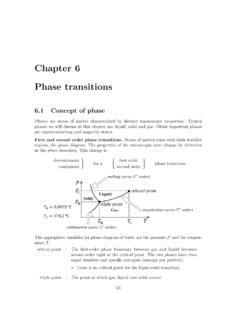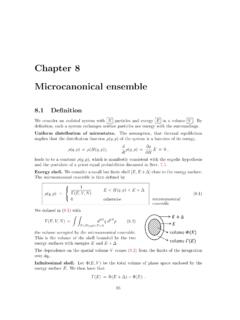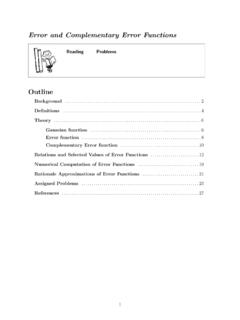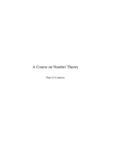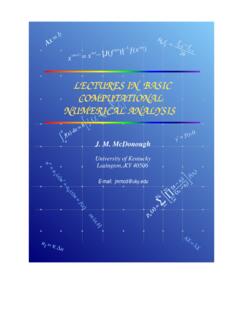Transcription of Chapter 5 Thermodynamic potentials - uni-frankfurt.de
1 Chapter 5 Thermodynamic potentialsThermodynamic potentials are state functions that, together with the corresponding equa-tions of state, describe the equilibrium behavior of a system as a function of so-called natural variables . The natural variables are a set of appropriate variables that allow tocompute other state functions by partial differentiation of the Thermodynamic Internal energy UThe basic relation of thermodynamics is given by the equationdU = T dS +m i=1 Fidqi+ j=1 jdNj,( )where{F, q} denote the set of conjugate intensive and extensive variables that characterizea system.
2 For instance, for a gas{F, q} { P, V},and for a magnetic system{F, q} {B,M} .Chemical potential. The number of particles in the system is a natural extensivevariable for the free energy, we did keep it hitherto constant. The number of particle ofa distinct types j is denoted by Njin ( ), where j = 1, .. , . The respective intensivevariable, (and respectively the j), is denoted the chemical chemical potential become identical to the Fermi energy for a gas of Fermions (atlow temperatures, as we will discuss in ). Note that diffusion processes ( a membrane) may change individual Nj.
3 The number of particles needs thereforenot to be energy of a gas. Eq. ( ) is equivalent todU = T dS P dV + dN ,U = U(S, V, N)( )4748 Chapter 5. Thermodynamic POTENTIALSfor a gas with one species of particle, which implies thatT = U S V,N, P = U V S,N, = U N S,V.( )Response functions. The experimentally important response functions are obtained bysecond-order differentiation of the internal energy, 2U S2 V,N= T S V,N=TCV,CV= T S T V,N= T 2U S2 V,N 1 2U V2 S,N= P V S,N=1V S, S=1V 2U V2 S,N 1 Maxwell relations.
4 A Maxwell relation follows, as discussed already in ,from the differentiability of Thermodynamic potentials . An example of a Maxwell relationderived from the differential of the internal energy U = U(S, V, N) is V U N = N U V , V S= P N V,( )which relates the change of the chemical potential with the volume V to the (negativeof the) change of the pressure P with the number of particles Monoatomic ideal gasFor the monoatomic ideal we didfind hithertoP V = nRT,U =32nRT,CV=32nR .We now use these relations to derive an expression for U in terms of its natural We start with the entropyS(T, V ) S(T0, V0) =3nR2log TT0 + nR log VV0 =3nR2log UU0 + nR log VV0 of the ideal gas, as derived in , where we have used the ideal gas relationU = 3nRT/2 to substitute T and T0with U and U0in the second INTERNAL ENERGY U49 With CV= 3nR/2 we may write equivalentlyS S0CV= ln UU0 +23ln VV0 = ln UU0 VV0 2/3 ,( )which can be solved for the internal energy asU(S, V ) = U0 V0V 1e(S S0)/CV, = 5/3.
5 ( )Eq. ( ) is the fundamental equation for the ideal gas, with U(S, V ) as the thermodynamicpotential. S, V are the independent natural Thermodynamic potential vs. equation of stateThe natural variables for U are S and V , which means that if the function U(S, V ) isknown for a given system we can obtain all Thermodynamic properties of the systemthrough the differentiation of U(S, V ). The equation of stateU = U(T, V, N)( )for the internal energy U is on the contrary not a Thermodynamic potential. This isbecause thefirst derivatives of ( ) yield the specific heat CVand the energy equation( ), U T V= CV, U V T= T P T V P ,but not the dependent variables S and P.
6 Note the marked difference to ( ). Classical mechanics vs. thermodynamicsThere is a certain analogy between the potential V and internal energy U of classicalmechanics and thermodynamics respectively:Classical mechanicsThermodynamicsPotentialV (x, y, z)U(S, V, N)Independent variablesx, y, zS, V, NDependent variablesFx= V xP = U V S50 Chapter 5. Thermodynamic legendre transformationA disadvantage of using U(S, V, N) as a Thermodynamic potential is that the naturalvariable S is difficult to control in the lab. For practical purposes, it is more convenientto deal with other Thermodynamic potentials that can be defined by making use of theLegendre transformations in classical mechanics.
7 We recall the legendre transfor-mation connecting the legendre function L(q, q) with the Hamilton function H(q, p), : pq H(p)..where q is the generalized coordi-nated and, q and p respectively thevelocity and the momentum, withp = L q q,at constant coordinate q, andH(q, p) = p q L(q, q) . ( )A legendre transformation is hencea variable transformation, q p, where one of the variables, here the momentum p, isdefined by the slope of original function, viz by the slope of the Lagrange function L(p, q). legendre transformations in thermodynamicsAs an example we consider the transformationU(S, V, N) H(S, P, N),from the internal energy U(S, V, N) to the enthalpy H(S, P, V ).
8 The form is, as discussedshortly in ,H(S, P, N) = U(S, V, N) + P V,P = U V S.( )Note that the pressure is defined as the (negative) slope of the internal energy U withrespect to the volume V , in analogy to the transformation from the velocity q to themomentum p = L/ q in classical mechanics. Note however the different sign conventionsbetween ( ) and ( ).Differential. The legendre transformation ( ) allows to evaluate withdH = d U + P V = T dS P dV + dN + P dV + V dP ,the differential dH of the enthalpy in terms of its natural variables S, P and N.
9 Theresult isdH = T dS + V dP + dN.( ) legendre The four basic Thermodynamic potentialsA Thermodynamic potential for a system with variable number of particles should dependon{ , N} as well as a thermal variable and a mechanical variable, which can be (for agas):thermal: S (extensive) T(intensive)mechanical: V (extensive) P (intensive)The four possible combinations of these variables,Intensive variablesExtensive variablesP Enthalpy H(S, P) S Gibbs enthalpyInternal energyG(T, P)U(S, V ) T Free energy F(T, V ) Vdefine four basic Thermodynamic potentials :U(S, V, N) internal energyH(S, P, N) enthalpyG(T, P, N) Gibbs enthalpyF(T, V, N) free energyGibbs enthalpy.
10 We did already discuss the differentials ( ), dU = T dS P dV + dN,and ( ) of respectively the free energy U(S, V, N) and of the enthalpy H(S, P, N). Forthe Gibbs enthalpy one has in analogyG = U(S, V, N) T S + P V,dG = SdT + V dP + dN .( )Free energy. The natural variables T, V and N of the free energy F = F(T, V, N) arestraightforward to access experimentally. The free energy is hence an often consideredthermodynamic potential. It obeysF = U(S, V, N) T S,dF = SdT P dV + dN .( )Differential relation betwen free and internal energy.
